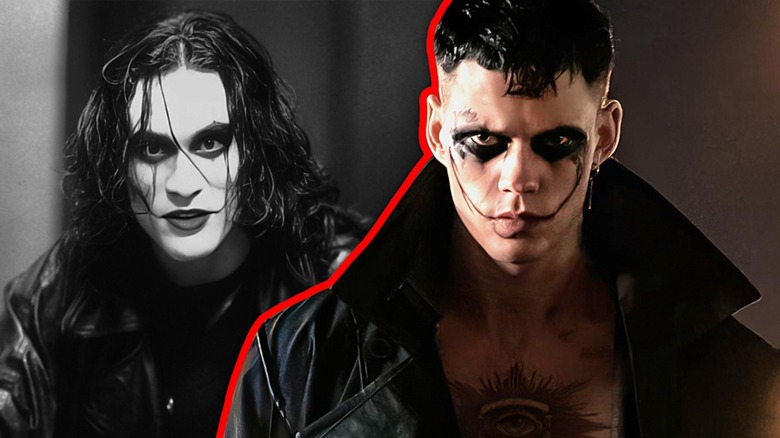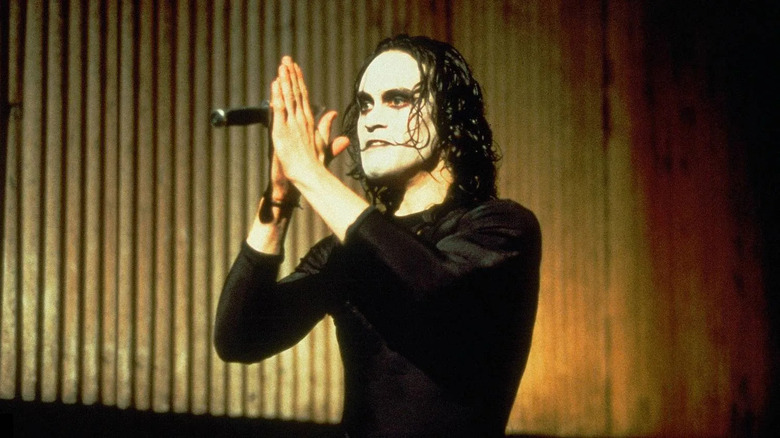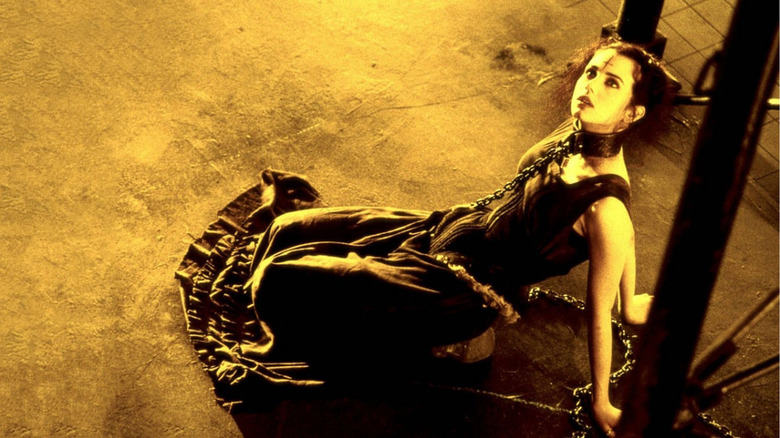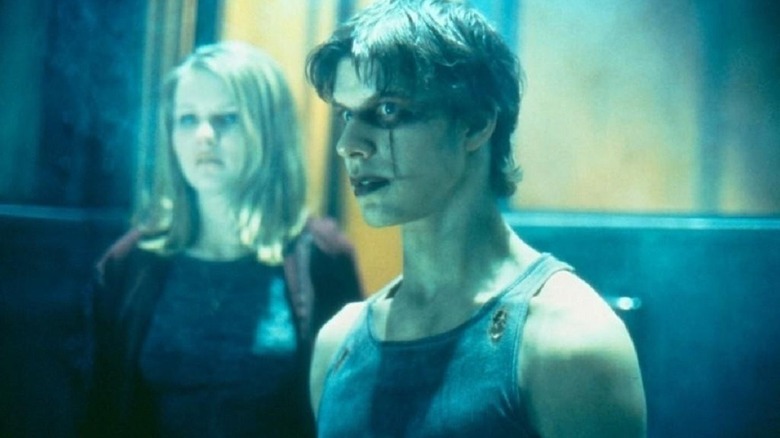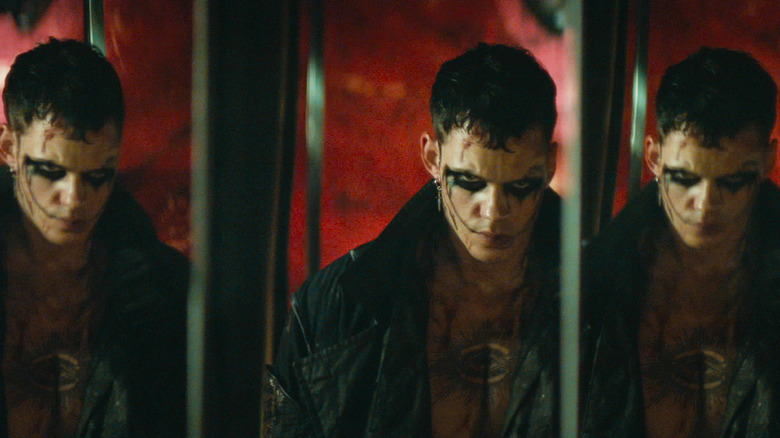The Long And Dark History Of The Crow Franchise
The first issue of James O'Barr's comic book "The Crow" was initially published in February 1989, and it joined the ranks of a growing contingent of broody, Goth-friendly comics that spoke to a growing cultural obsession with death and angst. The story of "The Crow" is incredibly bleak. A young man named Eric and his fiancée Shelley are attacked in an alleyway by a random group of thugs. Eric is shot in the head and left paralyzed, while Shelley is assaulted, beaten, and murdered. Eric later succumbs to his wounds and dies at the hospital.
An invisible mystical crow, however, finds Eric's soul in the afterlife a year later, and returns it to his body, resurrecting him. Eric is more or less a zombie and can be wounded without dying. He also becomes an introspective poet, often quoting Rimbeau and even Joy Division lyrics. He instantly became the poster boy for broody Goths everywhere, an aspirational figure for those fond of pancake white, long leather coats, and a love of the Cure. Eric begins a quest to find and murder the men who killed him and his fiancée — specifically, the evil drug dealer Top Dollar, the gang leader T-Bird, and his right-hand man Funboy.
Tonally speaking, "The Crow" is sad and tragic. Eric may look "cool," but the comic is not a power fantasy. Indeed, as James O'Barr has admitted, it was made as a form of dark therapy after his real-life fiancée died in a car wreck.
"The Crow" was famously adapted into a feature film by director Alex Proyas in 1994, beginning a media legacy that has lasted to this day. The 1994 film has spawned three sequels, a TV series, and video games, with a remake slated to reach theaters in time to mark its 30th anniversary.
The start of The Crow
"The Crow," recall, began with tragedy. O'Barr once said in an interview that he used his bleak, violent comic to get over the death of a loved one, but also that it didn't work. Speaking to Dike Blair, he once explained:
"I thought that by putting some of this anger and hate down on paper that I could purge it from my system. But, in fact, all I was doing was intensifying it — I was focusing on all this negativity. As I worked on it, things just got worse and worse, darker and darker. So, it really didn't have the desired effect; I was probably more f***ed up afterwards than before I started."
O'Barr's personal tragedy was compounded by an infamous accident on the set of Proyas' film. One of the prop guns on set had a flake of fake bullet still lodged in its barrel when it was loaded with blanks. When a blank was fired at star Brandon Lee, it dislodged the flake, shooting it into the actor and killing him. The film was completed with his stunt double, Chad Stahelski. Lee's death was well-known before the film's release, emphasizing the sadness of the material.
The 1994 flick is one of the most 1990s films of the 1990s. It takes place in a strange, super-stylized version of Detroit that very much resembles Tim Burton's version of Gotham City. Proyas similarly envisioned Eric to be more of a superhero type character whose body can heal from all wounds. The titular Crow is also visible in this version, serving as an informant and a kind of animal sidekick. The film's soundtrack included material by The Cure, Stone Temple Pilots, Nine Inch Nails, Panetra, Helmet, and The Jesus and Mary Chain. It's great.
The Crow's first sequel
Eric Draven's story is fulfilled at the end of "The Crow" when he manages to get his revenge. Rather than do the comic book thing and leave the character eternally trapped as an angst-infected, supernatural vigilante, the franchise wisely let Eric rest. "The Crow" was massively popular, however, and seemingly turned a profit at the box office before even accounting for the overwhelming VHS and soundtrack CD sales. A sequel was floated early during the original film's first wave of success, culminating with a follow-up called "The Crow: City of Angels" releasing in theaters in 1996.
"City of Angels," as the title implies, transposes the action to Los Angeles, with the titular Crow attaching itself to a new character in the form of Ashe Corven, played by Vincent Pérez. In the first "Crow," Eric was friends with a young girl named Sarah (Rochelle Davis). By the time "City of Angels" begins, Sarah has grown up into a death-savvy Gothic tattoo artist (now played by Mia Kirshner). It's Sarah who explains the rules of the crow to Ashe after he and his young son are murdered by drug dealers. Like Eric before him, Ashe uses his newfound undead superpowers to enact his revenge.
In a wild twist, however, Ashe's killer (Richard Brooks) captures Ashe's crow, kills it, drinks its blood, and steals Ashe's immortality powers. In the film's climax — a knock-down, drag-out fight, natch — Ashe has to call upon a whole murder of crows to fly to the rescue and kill Brooks' character. Sarah, quite tragically, also dies in the final conflagration.
"City of Angels" wasn't well-received, with critics feeling it didn't have the mood or the tragedy of the original. It's more stylish than anything. It wasn't the end of the "Crow" franchise, though.
The Crow into the 2000s
Even though "City of Angels" was something of a bomb, the owners of the "Crow" property still insisted on milking the franchise while '90s angst was hot. In 1998, Eric Draven returned for the reboot TV series "The Crow: Stairway to Heaven," which lasted for 22 episodes over one season. The TV series starred Mark Dacascos as Eric and expanded the plot of the 1994 film into something that could stretch into 22 hours' worth of material. Naturally, there were a lot of new magical conceits, spirits, and additional abilities attached to the crow. In a weird twist, a dead Russian gangster even becomes the host to the spirit of Rasputin.
After "Stairway to Heaven" wasn't very successful, it seemed like "The Crow" was finally over. The 1990s were coming to an end and the personal angst of the franchise was falling out of fashion. Regardless, interest in the property remained strangely fevered. It helped that Rob Zombie was said to have been working on "The Crow 2037," an ultra-violent sci-fi version of the story. That film never came to pass, but it was talked about for many years.
Eventually, Dimension released "The Crow: Salvation" in 2000, which starred Eric Mabius as (sigh) Alexander Corvus, the recipient of the Crow's immortality. Crovus was executed in the electric chair for a murder he didn't commit, and was brought back to kill the real killer. Kirsten Dunst appeared as his helper/friend. It was released straight-to-video and no one liked it. That was followed by "The Crow: Wicked Prayer" in 2005 starring Edward Furlong as (bigger sigh) Jimmy Cuervo. Jimmy sough to take revenge against a Satanic biker (played by David Boreanaz) and his girlfriend (played by Tara Reid). Even fewer people liked that one.
The Crow remake
One might think that after four movies, a TV series, and the death of the 1990s, "The Crow" would be played out. This article doesn't even mention the video game, the tie-in novels, or the continuing comic book series. There is a lot of "Crow" media in the world. But because it's Hollywood's habit to try to get milk from a bird, they put a bucket down next to the franchise and tried to get a little more precious fluid out of it. Ever since 2008, there has been a talk of a remake or a reboot of James O'Barr's comic. The dark legacy of Lee's death still hangs over the franchise, and O'Barr had to do a lot of soul-searching before he felt the well could be visited again, but a remake was eventually put into production. This was after multiple stalled reboots that had popped up over the years.
/Film has written before about the long road "The Crow" had to take getting from there to here. It's been a long time, but it's time is finally near. It had angst of the heart.
The new film, due in theaters soon, stars Bill Skarsgård as Eric, with FKA Twigs playing his tragically murdered bride-to-be. Because '90s Goth is far, far out of fashion, Eric has been visually reworked into a tattooed edgelord with sloppy makeup and exposed abs. Previews make the film look more grounded and less stylized than the Alex Proyas version. It remains to be seen if this version of Eric will quote Rimbaud and listen to Joy Division.
We'll all find out when "The Crow" opens in theaters on August 23, 2024.
